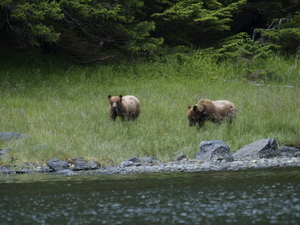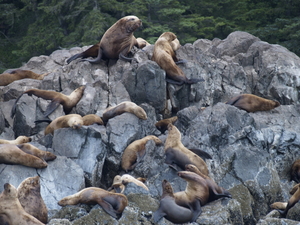Unforgiving Majesty: Sailing Alaska
In the wilderness of southeast Alaska, our writer discovers the thrill of conservation and the drama of nature
Photos and Story By Theresa Storm
My senses are heightened, every nerve on full alert. Like a dog, I sniff the sun-warmed, briny air, laced with the heady scent of Sitka spruce, red cedar, and western hemlock, the towering old-growth trees rooted in the precipitous mossy slope that rises like an emerald curtain from the foot of this deserted, rock-strewn Alaska Panhandle beach.
My six fellow adventurers and I are about to start up Sitkoh Lake Trail on rugged southeastern Chichagof Island, deep in the Tongass National Forest. At 16.8 million acres, the Tongass is the nation’s largest national forest three times over, as well as the world’s largest remaining old-growth temperate rainforest. Today we’re going in search of grizzlies, known here on the coast as Alaskan brown bears.
Our guide is Kevin Smith, owner of Maple Leaf Adventures and captain of the Canadian-registered Maple Leaf, the handsome, classic tall ship that’s our home for this 12-day cruise through the untamed coastal wilderness of southeast Alaska. This area is so remote, Smith says, that some of Captain Vancouver’s old maps from 1792 are still in use, and there are places that are still uncharted.
Although this isn’t prime bear season – they come in greater numbers when sockeye and pink salmon surge up inland streams to spawn — we have already discovered fresh scat where beach meets forest. Shipboard naturalist Briony Penn quickly determines the omnivorous bruin was digging for rice root. Sedges, grasses, and other plants are also bear food, she informs us.
Smith doles out instructions: Stay with the group. Hike single file. Never run. Be silent.
My instincts are screaming. Living near the Canadian Rockies, I have spent a lifetime obeying ironclad rules to avoid bears when hiking and camping. The most important of these rules: Make noise. Talk, sing, or ring bear bells. A surprised bear can be an aggressive bear, especially if protecting cubs or food.
Silence goes against everything I have learned. But then again, Smith’s goal is to find the grizzly bear, Ursus arctos horribilis, perceived by most as a terrifying predator, the terrestrial equal of the great white shark.
Although I am nervous, I know I’m in good hands. Smith is a former park ranger and one of 22 full guides certified by the Commercial Bear Viewing Association of British Columbia, a first-of-its-kind nonprofit he helped co-found to promote sustainable bear viewing and protect wild bears and their ecosystems.


One of Smith’s bear-guide duties is patiently teaching guests that grizzlies are not the savage, human-eating predators most of us fear. It’s critical to respect them and understand their behavior, he explains.
“You’re the visitor here, and the bear is at home.”
We set off into the dense, sun-dappled forest, where massive trunks soar toward the light, boughs heavy with Usnea, a lichen commonly called old man’s beard. Smith carries no gun, no pepper spray, and no bells. The trail, lined with salmonberry bushes, a favorite grizzly food, is steep and difficult to follow, and we soon abandon our hike.
I’m relieved we didn’t meet Mr. Bear, but also disappointed. I desperately want to see the powerful, iconic bruins in their natural habitat – just from a nice, safe distance.
There’s still time. It’s only day eight of the trip, and the early-July weather is gorgeous, the sky postcard-blue. Long gone are the driving rain and high seas that made the start of our voyage a little rough and a tinge green as we crossed Dixon Entrance from British Columbia to Alaska.
“Nature is not forgiving here,” Smith explained at the time, humorlessly reminding us that rain should be expected in a rainforest.
Back on board after our bear-seeking excursion, that rocky start a week ago is long forgotten as we happily sun on the Maple Leaf’s immaculate deck and pick through the sea asparagus, rice root, and sea plantain we’ve just foraged for dinner (the bears would be unimpressed).

What does linger in my mind is the moment we saw our first humpback whales, early on day three. The rain had abated and diamond sparkles shot off Frosty Bay, whose glassy surface was marred only by jumping salmon. Overhead, two bald eagles mobbed with a raven.
We were jubilant just to see the sun. Then a cry of “Whales!” was raised as two humpback whale mothers with calves appeared, hunting.
Grabbing cameras and binoculars, we rushed to the rail to get a first look at the behemoth mammals that call the frigid, krill-rich Alaskan waters their summer feeding ground.
Humpbacks, we learned, are making a remarkable recovery in the North Pacific. Protected from commercial whaling since 1966, when their numbers were depleted to between 1,400 and 1,600, the population is now higher than 21,000, according to recent research from the U.S. government’s National Oceanic and Atmospheric Administration.
Despite this, humpbacks are one of five state-listed endangered species and are also designated as endangered under the United States Endangered Species Act.
“We are in the process of reviewing the status,” explained Doug Vincent-Lang, endangered species coordinator for the Alaska Department of Fish and Game. “Initial information suggests these whales are no longer threatened with extinction in Alaska.”
It’s thrilling news, proof positive that conservation can work.
Since that first sighting, we’ve seen plenty more whales, and our excitement never ebbs, especially when we’re treated to displays of breaching or tail lobbing.
“Nature’s drama at its finest!” enthuses Smith, his face animated with love for this wilderness coast and the treasures it harbors. “The biodiversity is huge here,” he adds, promising much more “raw nature” to come.
My camera is rarely still. The wild west coast delivers abundant and ever-changing wildlife – racing white-sided dolphins, lightning-fast Dall’s porpoises, sleepy harbor seals, hunting orcas, adorable tufted puffins, soaring bald eagles, and even one swimming, laden with a slippery, thrashing salmon destined to be dinner once onshore.
Each morning, Smith divulges the agenda of marine and terra firma adventures his crew of four have planned to help us explore Alaska. Enthusiastic naturalist Penn leads expeditions to intertidal zones, river estuaries, bogs, beaches, forests, and towns, as does the captain himself from time to time.
Aboard zippy inflatables, we maneuver among rocky outcroppings to examine low tidal sea life — sea stars, bull kelp, edible sea lettuce, hermit crabs, and other critters. We circle St. Lazaria Island, a seabird-nesting refuge straight from the set of Jurassic Park, and cautiously motor close enough to the icy pinnacles of Endicott Glacier to be startled by the gunshot cracks of silvery-blue ice calving.
We kayak, hike in the near silence of ancient rain forests, and make cedar mats. We take our turn at the ship’s wheel and soak in natural hot springs a stone’s throw from a thundering waterfall.
Best of all, over the course of our journey we hear more good news: Humpbacks are just one of Alaska’s conservation success stories.


On a Zodiac visit to a non-breeding Steller sea lion colony at Three Brothers, we see cameras mounted on rocks and individual animals branded with numbers. As we approach cautiously, Smith informs us the world’s largest sea lions are being studied.
n 1990, due to a dramatic population decline in Alaska, Steller sea lions were federally listed as threatened (east of 144ºW longitude, our location) and endangered (west of 144º). The good news is that, according to the Alaska Department of Fish and Game, the eastern stock has increased more than three percent annually since the 1970s, likely exceeding 50,000 animals in 2007. Even better, promising new breeding rookeries have been established.
As we sail north up Frederick Sound, our eyes strain for the last chance to see whales and the first to see Northern sea otters.
“What I like about Alaska is it paces itself,” Penn muses.
Sure enough, shouts soon ring out as the swimming head of the cutest of all marine mammals is sighted. Later, in Sitka Sound, we are delighted by a small raft of shy sea otters bobbing on their backs on bull kelp fronds, the world’s fastest growing plant.
Nervous, they keep their distance. Who can blame them? Hunted to extinction in southeast Alaska during the commercial fur trade, they have thrived since 403 animals were reintroduced at six sites in the 1960s. The population has now rebounded to an estimated 25,000, another marine conservation success story.
At last, on day nine, we sight the brawny ursines we’ve been seeking — a mama brown bear and her chubby cub, about two years old, munching sedge on the shore of Kalinin Bay. We excitedly shoot – cameras, of course – while the bears, unperturbed, continue mowing and chewing.
Today, my nerves are calm. Smith’s impeccable bear-guiding credentials have assuaged much of my fear, but nevertheless I am glad to be observing from the safety of the Zodiac. I still hope never to encounter a grizzly on a forest path, but I have newfound appreciation for the threats they face in an increasingly human world.
Like many Maple Leaf guests, I struggle to summarize my journey to one of the planet’s last great wildernesses. Captain Smith, however, has words for the experience: “Alaska is like a watery version of an African safari.”
Learn More:
Alaska Sailing Adventure
Maple Leaf Adventures
British Columbia Travel
Theresa Storm on Twitter



